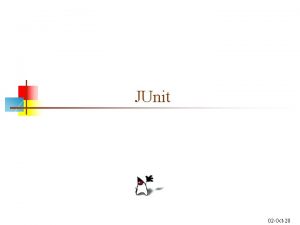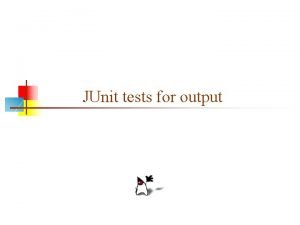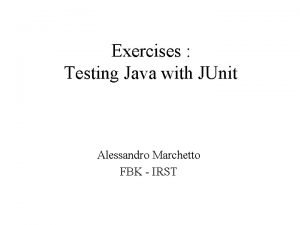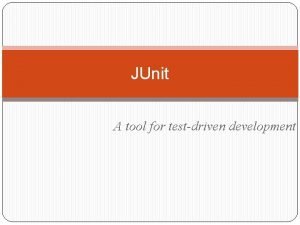JUnit A tool for testdriven development History Kent
















- Slides: 16

JUnit A tool for test-driven development

History ¢ ¢ ¢ Kent Beck developed the first x. Unit automated test tool for Smalltalk in mid-90’s Beck and Gamma (of design patterns Gang of Four) developed JUnit on a flight from Zurich to Washington, D. C. Martin Fowler: “Never in the field of software development was so much owed by so many to so few lines of code. ” Junit has become the standard tool for Test-Driven Development in Java (see Junit. org) Junit test generators now part of many Java IDEs (Eclipse, Blue. J, Jbuilder, Dr. Java) Xunit tools have since been developed for many other languages (Perl, C++, Python, Visual Basic, C#, …)

Why create a test suite? ¢ ¢ Obviously you have to test your code—right? l You can do ad hoc testing (running whatever tests occur to you at the moment), or l You can build a test suite (a thorough set of tests that can be run at any time) Disadvantages of a test suite l It’s a lot of extra programming • True, but use of a good test framework can help quite a bit l You don’t have time to do all that extra work • False! Experiments repeatedly show that test suites reduce debugging time more than the amount spent building the test suite ¢ Advantages of a test suite l Reduces total number of bugs in delivered code l Makes code much more maintainable and refactorable

Architectural overview ¢ ¢ JUnit test framework is a package of classes that lets you write tests for each method, then easily run those tests Test. Runner runs tests and reports Test. Results You test your class by extending abstract class Test. Case To write test cases, you need to know and understand the Assert class

Writing a Test. Case To start using JUnit, create a subclass of Test. Case, to which you add test methods ¢ Here’s a skeletal test class: ¢ import junit. framework. Test. Case; public class Test. Bowl extends Test. Case { } //Test my class Bowl ¢ ¢ Name of class is important – should be of the form Test. My. Class or My. Class. Test This naming convention lets Test. Runner automatically find your test classes

Writing methods in Test. Case ¢ ¢ ¢ Pattern follows programming by contract paradigm: l Set up preconditions l Exercise functionality being tested l Check postconditions Example: public void test. Empty. List() { Bowl empty. Bowl = new Bowl(); assert. Equals(“Size of an empty list should be zero. ”, 0, empty. List. size()); assert. True(“An empty bowl should report empty. ”, empty. Bowl. is. Empty()); } Things to notice: l Specific method signature – public void test. Whatever() • Allows them to be found and collected automatically by JUnit l Coding follows pattern l Notice the assert-type calls…

Assert methods ¢ ¢ ¢ Each assert method has parameters like these: message, expected-value, actual-value Assert methods dealing with floating point numbers get an additional argument, a tolerance Each assert method has an equivalent version that does not take a message – however, this use is not recommended because: l l messages helps documents the tests messages provide additional information when reading failure logs

Assert methods ¢ ¢ ¢ ¢ assert. True(String message, Boolean test) assert. False(String message, Boolean test) assert. Null(String message, Object object) assert. Not. Null(String message, Object object) assert. Equals(String message, Object expected, Object actual) (uses equals method) assert. Same(String message, Object expected, Object actual) (uses == operator) assert. Not. Same(String message, Object expected, Object actual)

More stuff in test classes ¢ ¢ ¢ Suppose you want to test a class Counter public class Counter. Test extends junit. framework. Test. Case { l This is the unit test for the Counter class public Counter. Test() { } //Default constructor protected void set. Up() l Test fixture creates and initializes instance variables, etc. protected void tear. Down() l Releases any system resources used by the test fixture public void test. Increment(), public void test. Decrement() l These methods contain tests for the Counter methods increment(), decrement(), etc. l Note capitalization convention

JUnit tests for Counter public class Counter. Test extends junit. framework. Test. Case { Counter counter 1; public Counter. Test() { } // default constructor protected void set. Up() { // creates a (simple) test fixture counter 1 = new Counter(); } public void test. Increment() { assert. True(counter 1. increment() == 1); assert. True(counter 1. increment() == 2); } } public void test. Decrement() { assert. True(counter 1. decrement() == -1); } Note that each test begins with a brand new counter This means you don’t have to worry about the order in which the tests are run

Test. Suites ¢ ¢ Test. Suites collect a selection of tests to run them as a unit Collections automatically use Test. Suites, however to specify the order in which tests are run, write your own: public static Test suite() { suite. add. Test(new Test. Bowl(“test. Bowl”)); suite. add. Test(new Test. Bowl(“test. Adding”)); return suite; } ¢ ¢ Should seldom have to write your own Test. Suites as each method in your Test. Case should be independent of all others Can create Test. Suites that test a whole package: public static Test suite() { Test. Suite suite = new Test. Suite(); suite. add. Test. Suite(Test. Bowl. class); suite. add. Test. Suite(Test. Fruit. class); return suite; }

JUnit in Eclipse ¢ To create a test class, select File New Other. . . Java, JUnit, Test. Case and enter the name of the class you will test Fill this in This will be filled in automatically

Running JUnit Second, use this pulldown menu First, select a Test class Third, Run As JUnit Test

Results Your results are here

Unit testing for other languages ¢ Unit testing tools differentiate between: l l ¢ Basic unit of testing: l ¢ Errors (unanticipated problems caught by exceptions) Failures (anticipated problems checked with assertions) CPPUNIT_ASSERT(Bool) examines an expression CPPUnit has variety of test classes (e. g. Test. Fixture) l Inherit from them and overload methods

More Information ¢ http: //www. junit. org Download of JUnit l Lots of information on using JUnit l ¢ http: //sourceforge. net/projects/cppunit l ¢ C++ port of Junit http: //www. thecoadletter. com l Information on Test-Driven Development
 Thecoadletter
Thecoadletter Kent internet risk assessment tool
Kent internet risk assessment tool Vogella junit
Vogella junit Junit tutorial eclipse
Junit tutorial eclipse Junit
Junit Junit test private methods
Junit test private methods Fixture junit
Fixture junit Junit testing
Junit testing Junit exercises
Junit exercises Junit test concurrency
Junit test concurrency Junit.framework.assert
Junit.framework.assert Tdd junit
Tdd junit Informatica def
Informatica def History of kent repertory
History of kent repertory Potter's tool is data cleaning tool
Potter's tool is data cleaning tool Kontinuitetshantering
Kontinuitetshantering Typiska novell drag
Typiska novell drag





























